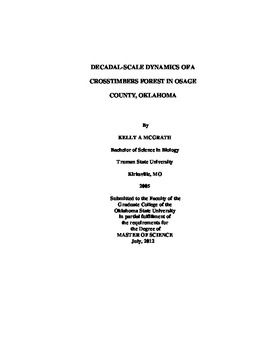| dc.contributor.advisor | Palmer, Michael W. | |
| dc.contributor.author | McGrath, Kelly A. | |
| dc.date.accessioned | 2014-04-15T21:59:49Z | |
| dc.date.available | 2014-04-15T21:59:49Z | |
| dc.date.issued | 2012-12-01 | |
| dc.identifier.uri | https://hdl.handle.net/11244/9183 | |
| dc.description.abstract | The objective of this research was to answer several questions regarding Crosstimbers stand dynamics: 1)What are the dynamics of the stand in terms of mortality and recruitment? (2)How do size-specific growth and mortality vary between the two dominant oak species, Q. stellata and Q. marilandica? (3)Are the dynamics consistent with a forest in steady state? (4)What is the age structure of the stand? In 1998, Jos� Ram�n Ar�valo placed a rectangular (200m x 200m) plot within an area of forest at the Tallgrass Prairie Preserve in Osage County, Oklahoma. All stems 2.5cm in diameter at breast height (DBH, 1.3m) were tagged with an individual identification number on an aluminum tag, and their geographic coordinates were recorded. Each tree's species, diameter, and status (alive or dead) were also recorded. I resampled the stand in 2008, again recording status, changes in DBH, and recruitment of new stems. Using these data, I calculated basal area and developed diameter distributions for both time points, and measured growth rates and mortality for both species. Using a stratified random sampling design I measured the heights of 96 stems across 12 size classes (3cm increments starting at 2.5cm DBH). I also used increment bores taken from 48 stems across the same 12 size classes to assess the age structure of the stand and examine the relationship between age and diameter.:Over a 10 year period, basal area increased and the number of stems decreased by 33%, with the majority of those deaths in Quercus marilandica stems. Only five stems have been recruited into the stand. The diameter distribution for both species in both years was unimodal, with the majority of stems in the smaller size classes. The peak of the diameter distributions shifted toward slightly larger stems (from 7.5cm DBH to 10cm DBH) during the 10 year study period. Growth rate is greatest for stems of medium size (between 15-25cm DBH). Age analysis of the stand revealed a relatively even-aged stand. There is a positive relationship between height and diameter much scatter. Diameter generally increases with age, although age can vary drastically within size classes. Dynamics indicate that this forest stand is undergoing thinning of stems. | |
| dc.format | application/pdf | |
| dc.language | en_US | |
| dc.publisher | Oklahoma State University | |
| dc.rights | Copyright is held by the author who has granted the Oklahoma State University Library the non-exclusive right to share this material in its institutional repository. Contact Digital Library Services at lib-dls@okstate.edu or 405-744-9161 for the permission policy on the use, reproduction or distribution of this material. | |
| dc.title | Decadal-scale Dynamics of a Crosstimbers Forest in Osage County, Oklahoma | |
| dc.type | text | |
| dc.contributor.committeeMember | Steets, Janette | |
| dc.contributor.committeeMember | Will, Rodney | |
| osu.filename | McGrath_okstate_0664M_12347.pdf | |
| osu.college | Agricultural Sciences and Natural Resources | |
| osu.accesstype | Open Access | |
| dc.description.department | Department of Natural Resource Ecology and Management | |
| dc.type.genre | Thesis | |
| dc.subject.keywords | crosstimbers | |
| dc.subject.keywords | forest structure | |
| dc.subject.keywords | quercus | |
| dc.subject.keywords | species composition | |
